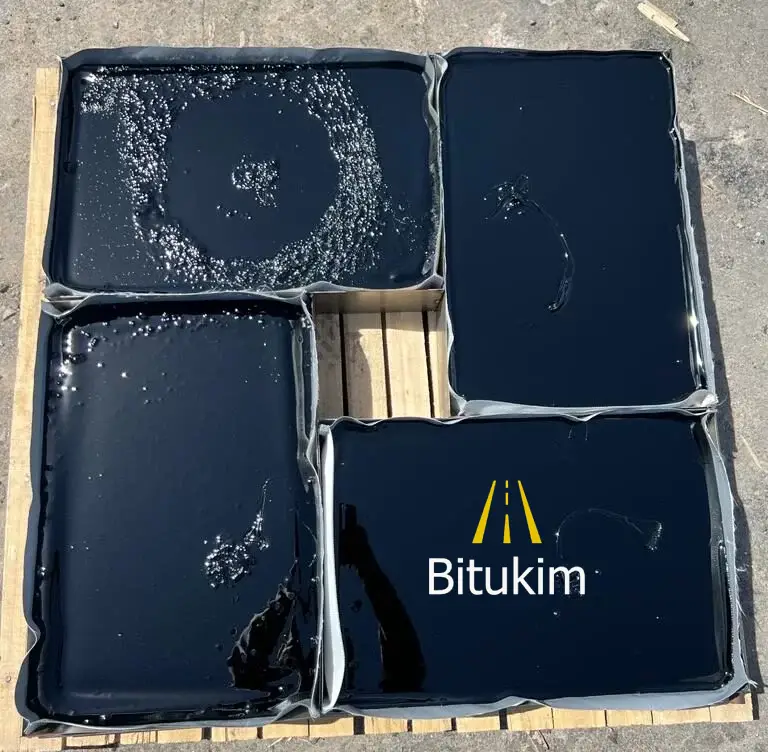
Oxidized Bitumen 105/15 Description
Oxidized bitumen 105/15, or blown asphalt, is a semi-solid bitumen that is made by blowing hot air through penetration-grade bitumen. The process creates a chemical reaction known as oxidation that changes the bitumen’s structure and enhances its physical properties—particularly increasing its softening point and decreasing its penetration rate. As a result, the product is much more resistant and less prone to temperature variations. These characteristics make oxidized bitumen 105/15 an ideal product for application in scenarios where long-term performance and resistance to heat, pressure, and environmental stress are paramount.
What Does 105/15 Mean?
The “105/15” in oxidized bitumen refers to two specific physical characteristics of the product. The 105 value is the softening point in degrees Celsius and represents the temperature at which bitumen softens. The 15 value is the penetration value in deci-millimeters (dmm) that describes the depth of penetration by a reference needle under standardized conditions. This particular grade—105/15—is of high softening point and low penetration value, which makes it hard, heat-stable, and suitable for demanding industrial applications.
Features and Advantages of Oxidized Bitumen 105/15
High Softening Point: Hard and stable even at elevated temperatures.
Low Penetration Value: Forecasts a hard, resistant, non-deformable material.
Thermal Stability: Maintains performance at a broad temperature range.
Good Adhesion: Sticks properly to various substrates like metal, concrete, and asphalt.
Waterproofing Capacity: Possesses a sufficient barrier against water ingress.
Environmental Resistance : Resistant to environmental conditions without deteriorating.
Long Lifespan in Service: Exhibits durability and low maintenance under long-term applications.
Improved Resistance to Aging: Resistant to cracking and deteriorating with aging.
How is Oxidized Bitumen 105/15 manufactured?
Oxidized bitumen is a multi-phase production process that demands strict control. To begin with, high-grade bitumen is heated in a reactor to its usual temperature of between 240 and 260 degrees Celsius. Once the temperature is attained, air is blown through the bitumen using specialized equipment. The air blowing causes the bitumen molecules to react with oxygen, creating longer polymer chains that result in a more stable and harder end product.
Once the material reaches the desired level of oxidation, it is cooled to stop further chemical reactions. It may then be filtered to remove impurities and occasionally blended with additives to enhance some of the properties such as flexibility or elasticity. Finally, the final product is packaged in forms such as blocks, bags, and drums, depending on how it is to be utilized and transported.
Uses in Industry and Construction
Due to its multi-functional performance, oxidized bitumen 105/15 is widely used in various industries. In the construction industry, it is commonly used in roofing systems, where it serves as a rugged layer beneath shingles or as an element of waterproofing membranes. Its softening point makes it impossible for it to melt or deform under sunlight, and its chemical resistance ensures that the structure remains clean from outside impurities.
In asphalt road construction, blown asphalt is used for expansion joints sealing and joint sealing in order to enable roads to endure movements induced by temperature. It is also used in pipeline coating in order to prevent corrosion and water intrusion, particularly in the gas, oil, and water industries. In the electrical sector, it serves as a protecting and insulating substance on transformers and cable, where its nonconductivity plays a crucial role.
Precautions against accidents in the handling of Oxidized Bitumen 105/15
Ventilation:
Use proper air ventilation in working spaces to avoid contact with fumes during hot temperatures.
Personal Protective Equipment (PPE):
Use long-sleeved protective clothing and heat-resistant gloves.
Use safety glasses to avoid eye splashes.
Safety shoes are recommended in case of spillage.
Fume Control: Use extraction systems or masks during indoor work with high volumes.
Fire Safety:
Minimize contact with open flames and sparks.
Always maintain adequate fire extinguishers in reach.
Precaution on Spills:
In case of spills, allow material to solidify and cool before removal—do not apply water directly to burning bitumen.
First Aid:
In case of contact with skin by hot bitumen, cool immediately using water and seek medical attention.
Packaging
Oxidized bitumen 105/15 is available in different packaging to cater to the logistics of different industries. It is available in meltable polyethylene bags, kraft paper bags, carton boxes, and solid blocks with 20kg, 25kg, or 40kg sizes. Drums are also employed for bulk applications and export, where it can be shipped in one standard 20-foot container carrying approximately 23 metric tons of the product when filled in 25kg bags.
Final Thoughts
Oxidized bitumen 105/15 offers a strong blend of thermal stability, mechanical strength, water resistance, and chemical resistance. These are some of the reasons why construction, infrastructure, and heavy industries personnel favor this product for its ability to perform well in the long term and save on maintenance. Though it may be more expensive than regular bitumen, the durability and less frequent maintenance make it an economic choice in the big picture of project management.
Specification of Oxidized Bitumen 105/15
| Bitumen 105/15 | Test method | Unit | Specification |
|---|---|---|---|
| Specific gravity @25/25 C | ASTM D70 | (Kg/m3) | 1.05 approx. |
| Penetration @ 25°c | ASTM D5 | mm/10 | 10/20 |
| Softening point °c | ASTM D36 | °C | 100/110 |
| Loss on heating(wt) % | ASTM D6 | Wt. % | 0.2 max |
| Flashpoint c | ASTM D92 | °C | 250 min |
| Solubility is CS2(wt) % | ASTM D4 | Wt. % | 99.5 max |
| Spot test | A.A.S.H.O.T102 | — | Negative |

